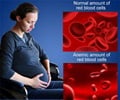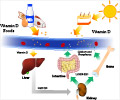Bacterial vaginosis (BV) is the most common vaginal infection in US women of childbearing age, and is common in pregnant women.
Bacterial vaginosis (BV) is the most common vaginal infection in US women of childbearing age, and is common in pregnant women. BV occurs when the normal balance of bacteria in the vagina is disrupted and replaced by an overgrowth of certain bacteria. Because having BV puts a woman at increased risk for a variety of complications, such as preterm delivery, there is great interest in understanding how it can be prevented.
Vitamin D may play a role in BV because it exerts influence over a number of aspects of the immune system. This hypothesis is circumstantially supported by the fact that BV is far more common in black than white women, and vitamin D status is substantially lower in black than white women. This relation, however, has not been rigorously studied.To assess whether poor vitamin D status may play a role in predisposing a woman to BV, Bodnar and coworkers at the University of Pittsburgh and the Magee-Womens Research Institute studied 469 pregnant women. The results of their investigation are published in the June 2009 issue of the Journal of Nutrition.
This prospective epidemiologic study investigated the relation between vitamin D status and BV in 209 white and 260 black women at <16 wk of pregnancy with singleton gestations. Blood samples were taken, and serum analyzed for 25-hydroxyvitamin D [25(OH)D], a marker of vitamin D status. 25(OH)D levels below 80 nmol/L are typically considered insufficient. Pelvic examinations were performed, and Gram-stained vaginal smears were assessed to diagnose BV.
The data indicate that 41% of all enrolled women had BV, and that 93% had 25(OH)D levels indicative of vitamin D insufficiency. Overall, women with BV had lower serum 25(OH)D concentrations than those without BV (P < 0.01). The prevalence of BV decreased as vitamin D concentration increased to 80 nmol/L (P < 0.001). Compared with 75 nmol/L, serum 25(OH)D concentrations of 20 nmol/L and 50 nmol/L were associated with 65% and 26% increases, respectively, in the likelihood of BV.
In summary, these findings suggest that vitamin D insufficiency is associated with BV in the first 4 mo of pregnancy. Further, poor vitamin D status may contribute to the strong racial disparity in the prevalence of BV in US women. Controlled intervention trials will be needed to confirm this hypothesis.
Source-Eurekalert
SRM














